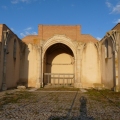The church of San Adrián de Sásabe, located in the Lubierre Valley near Borau, emerges as a historical witness of great relevance in the context of the Way of the Holy Grail. This ancient monastery, dating from the 9th century and probably used as a refuge by the bishops of Huesca during the Arab invasion, has been associated with the venerated relic of the Holy Grail, which adds an aura of mystery and transcendence to its legacy. Although today only the Romanesque church remains, built in the 12th century, its history is steeped in the search for and protection of such a sacred relic, which, according to local tradition, would have passed through several emblematic places until its final destination in the Cathedral of Valencia. This link with the legend of the Holy Grail adds a unique component to its importance in the spiritual and cultural pilgrimage route.
In addition to its historical and religious significance, the church of San Adrián de Sásabe also stands out for its Romanesque architecture, evidenced by its rectangular nave with presbytery and semicircular apse. The exterior architectural details, such as the simple checkerboard and semicircular arches, show the influence of the Romanesque art of Jaque and Lombardy, adding value to the artistic heritage of the region. However, the most surprising thing is the natural phenomenon that occurs inside: the gushing of water through the walls. This peculiarity, which could be attributed to the proximity of the Lubierre River and the nearby ravines, adds an element of awe and mysticism to the experience of visiting this ancient place of worship, merging history, faith and nature into a unique and fascinating destination for pilgrims and lovers of art and history.
- Address
A-2605 road near Borau, Huesca (Spain) - Web
https://www.borau.es/turismo-y-servicios-en-borau-la-jacetania/san-adrian-de-sasabe/ - Visiting Hours
Always open - What to see
Romanesque monastery whose walls gush with water







